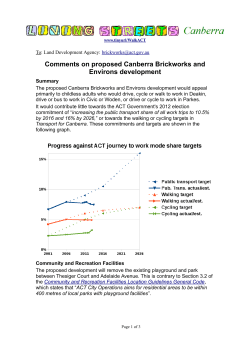
Getting Britain active: Setting the agenda for the new parliament
Getting Britain active: Setting the agenda for the new parliament Issued May 2015 Our vision and mission Enabling everyone to choose to take healthy everyday journeys will transform people’s lives and create better places to live, visit and work. It will tackle economic and healthcare challenges including congestion, air pollution, road safety, physical inactivity and obesity. Our vision is to transform the UK and create communities where children and their families are able to choose to walk and cycle to school, to work and recreation. Supporting local authorities to deliver better places to walk and cycle will allow people and communities to thrive, increase educational attainment, social cohesion and economic output and reduce social isolation and preventable ill health. To do this we need renewed political vision and commitments in the form of three actions for the new Government to take in the first 100 days: Leadership For the Prime Minister to commit personally to build on the progress made and funding committed in the last Parliament, in order that cycling and walking become the natural choice for shorter journeys. This requires making active travel a cross-cutting, cross departmental priority for the new Government. Investment To allocate long-term funding for cycling and walking in the 2015 Spending Review, equivalent to at least 5% of transport spending. The Government has estimated that total spend on cycling in England is currently around £5 per person a year, or less than 0.7% of transport spending; furthermore, about 80% of this will be terminated in 2015/16. Strategy For the Government to publish a commencement order for Part 2 of the Infrastructure Act 2015 before the summer recess; and to deliver a Cycling and Walking Investment Strategy by the end of 2015 that contains a long term vision, increased funding, investment plans and a comprehensive performance specification. Supported by the Richmond Group of Charities Why we need renewed commitments Walking levels are in long term decline and cycling levels remain low in all but a few cities. The scale of the problem before us compels urgent, national action and the opportunity that transforming our ability to travel far more by foot and bike offers is huge. Improving the economy: • Physical inactivity already costs the UK economy around £20 billion every year.1 • The annual cost of congestion, road collisions, physical inactivity, air pollution, carbon emissions and noise is at least £40 billion every year in English urban areas alone.2 • Well planned improvements to public spaces can improve footfall by up to 40%, retail footfall by about a third and retail turnover by up to 25%.3 Supporting jobs: • A recent DfT report commented that the Local Sustainable Transport Fund is potentially supporting between 4,700 and 6,150 jobs per year through a small programme of 96 projects with an expected long term positive impact on businesses and growth estimated as being in the order of £3bn.4 Improving health: • The official number of early deaths from particulate air pollution in the UK is 29,000 a year.5 • One in six deaths are linked to physical inactivity (equal to smoking as a cause of death).6 • Not only does physical activity reduce the relative risk of 20 non-communicable diseases by 20-50%7 it also improves clinical outcomes for those living with long term conditions. For example, walking for a mile every day could reduce prostate and breast cancer patients’ relative risk of dying by 30%.8 Who’s supporting this? This document has been written by a coalition of the country’s leading environment, transport and health organisations that includes: The Bicycle Association of Great Britain; British Cycling; Campaign for Better Transport; Campaign to Protect Rural England; Chartered Institution of Highways & Transportation; CTC, the National Cycling Charity; Institute of Highways Engineers; Living Streets; Sustrans; UK Health Forum; and the Richmond Group of Charities (Age UK, Asthma UK, Breakthrough Breast Cancer, British Heart Foundation, British Lung Foundation, Diabetes UK, Macmillan Cancer Support, The Neurological Alliance, Stroke Association and Rethink Mental Illness). For more information Claire Francis, Sustrans. Telephone 0207 954 3002 or email Claire.Francis@sustrans.org.uk 1 All Party Commission on Physical Activity, (2014), Tackling Physical Inactivity – a Coordinated Approach, http://activitycommission.com// 2 Cabinet Office (2009) Costs of urbantransport, http://webarchive.nationalarchives.gov.uk/20091204001009/http://www.cabinetoffice.gov.uk/ media/308292/urbantransportanalysis.pdf 3 The Pedestrian Pound, Living Streets (2013), http://www.livingstreets.org.uk/make-a-change/library/the-pedestrian-pound-the-business-case-forbetter-streets-and-places 4 DfT, Local Sustainable Transport Fund - Analysis of employment impacts (2015), https://www.gov.uk/government/uploads/system/uploads/ attachment_data/file/417702/lstf-employment_impacts.pdf 5 Public Health England (2014), Estimating Local Mortality Burdens associated with Particulate Air Pollution https://www.gov.uk/government/news/ estimates-of-mortality-in-local-authority-areas-associated-with-air-pollution 6 Lee I-M, et al. (2012) Effect of physical inactivity on major non-communicable diseases worldwide: an analysis of burden of disease and life expectancy. The Lancet 380: 219–29 & Murray et al. (2013) UK health performance: findings of the Global Burden of Disease Study (2010) The Lancet 381: 997-1020 7 Department of Health (2011). Start Active, Stay Active: a report on physical activity from the four home countries’ Chief Medical Officers 8 Campbell A, Foster J, Stevinson C, Cavill N. (2012) The Importance of Physical Activity for People Living With and Beyond Cancer: A Concise Evidence Review (Macmillan Cancer Support)
© Copyright 2025














